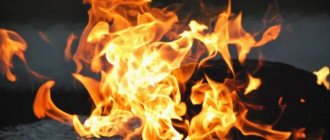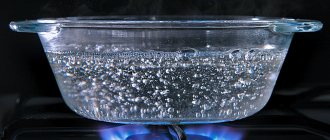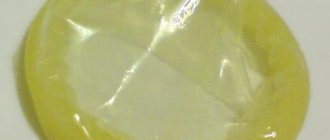How to extinguish a burning electrical appliance?
If an electrical appliance
is still under electrical voltage, the fire can be
extinguished
by covering the burning area with soil from a flower pot, washing powder, and baking soda. These substances will stop the access of air, and therefore oxygen, to the combustion site and extinguish the fire.
Interesting materials:
Where do the gypsies live? Where do ducks live in winter? Where do rooks from the Volga region winter? Where do sparrows winter? How to activate iPad if you forgot your Apple ID and password? How to activate troika for MCD through the application? How often should you feed your cat? How often do you need to change the oil in an automatic transmission? How often should you change your engine oil? How often should you change the oil in a manual transmission?
Fire hazard of flammable liquids
Flammable liquids include substances with a low flash point (oil, acetone, kerosene, gasoline, etc.), which ignite in a matter of seconds. The danger of flammable liquids lies in their ability to maintain the combustion process after removing the ignition source. At any time of the year and at any air temperature, the slightest spark caught in such a substance can cause ignition.
Petrol
Refers to flammable liquids.
There are different types of gasoline brands:
- aviation;
- automobile.
The conditions and purpose of their use vary.
| Gasoline brands | Flash point, ℃ | Self-ignition temperature, ℃ | Ignition area by volume, % | Ignition temperature limits, ℃ |
| Aviation | from –34 to –38 | 380–475 | 0,99–5,48 | from –38 to +5 |
| Automotive | from –27 to –39 | 255–370 | 0,76–5,16 | from –39 to –8 |
Kerosene
This flammable substance can cause an explosion when heated above 37 degrees. The fire spreads rapidly if extinguishing is not started in time. Eliminate the source of fire with powder fire extinguishers. The substance irritates the nasopharynx and skin, so when extinguishing fires, rescuers must wear protective gloves and masks.
Extinguishing oil on the surface of water: specifics of tank fires
In tanks, fires are preceded by an explosion of a mixture of vapors and air. In such a situation, they are immediately cooled with water from the leeward side, using special emergency equipment - fire monitors.
Actually, the fire is divided into three levels (the third is the most extensive). The most difficult fires to extinguish are low-level product fires under a pontoon or floating roof. In reinforced concrete tanks, part of the structure is destroyed, the other part heats up significantly, making it difficult to extinguish fires of oil and petroleum products.
Source
Powder and carbon dioxide fire extinguishers: distinctive features and operating rules
Fire extinguishing agents based on chemical or air-mechanical foam are gradually becoming a thing of the past. Today, to extinguish fires, powder and carbon dioxide fire extinguishers , which are more versatile and effective.
It is quite difficult to answer unequivocally which type is better, since each option has specific features that determine the scope of application. To make the right choice, you need to know the composition, operating principle and main characteristics of these fire extinguishing agents.
Chemical composition and principle of action
The main difference between powder and carbon dioxide fire extinguishers is the composition of the fire extinguishing agent (FSA) and the principle of its effect on the flammable material:
- Fire extinguishing powders are finely ground mineral salts that include various additives to prevent caking. The basis is phosphorus-ammonium salts, as well as sodium and potassium bicarbonate. Additives are usually hydrophobic substances such as aerosil, white soot and others. When the powder is sprayed over a surface, it creates a protective film that prevents air from penetrating and thus helps extinguish the fire.
- Carbon dioxide plants are charged with carbon dioxide, which is in a cylinder in liquid form. Due to chemical changes in the process of converting the liquid mixture into gas, the material is sharply cooled to -70°C. In addition to reducing the surface temperature, carbon dioxide displaces oxygen, which also helps to stop the fire.
On the left is a powder fire extinguisher, on the right is a carbon dioxide one.
One of the advantages of carbon dioxide products is the complete evaporation of the chemical agent and, as a result, the absence of its traces on the treated surface.
Therefore, it is beneficial to use such devices in residential premises, for example, to extinguish a fire caused by improper operation of a gas boiler.
By the way, you can read about the rules for installing a gas boiler in the article: installing a gas boiler in a private house: basic criteria.
Characteristics of fire extinguishing agents: fire class and fire extinguishing ability
There are 5 fire classes, each of which is designated by a specific letter of the Latin alphabet:
- A – hard materials (paper, plastic, wood);
- B – flammable liquids (gasoline, solvents);
- C – flammable gases (methane, propane-butane);
- D – metals (magnesium, lithium, sodium);
- E – installations under voltage.
The effectiveness of fighting a fire of a particular class is determined by a special characteristic - fire extinguishing ability, which is expressed by a numerical value, for example 2A or 55B.
It is worth noting that powder substances are used for processing solid materials, since carbon dioxide is ineffective in this case.
At the same time, carbon dioxide is successfully used to extinguish fires in electrical installations operating under voltages of up to 10,000 V.
Table comparing the use of different types of fire extinguishers for different classes of fire
How to maintain powder and carbon dioxide fire extinguishers
The operation of such fire extinguishing means involves monitoring their constant readiness, which includes checking the appearance, condition of components and fastenings. If faults are identified during the inspection, then the device must be sent for repair.
An important point is the recharging time of the fire extinguishing agent, which is determined by the general technical condition, the degree of operation and the influence of the external environment.
If there is no visible damage to the body and the cylinder is stored in a dry room, recharging is carried out once every five years.
For powder fire extinguishers that are stored outdoors, this procedure must be performed every year.
The cylinder must be refilled by an organization that has a state license to carry out such work, as well as having special equipment and appropriate specialists.
You can also watch a video comparing these two types of fire extinguishers:
Causes of ignition of gasoline and other flammable liquids
One reason is the combustion temperature of gasoline.
The flammable substance can be:
- hard;
- liquid;
- gaseous.
Attention! The most dangerous, from a fire safety point of view, are gases.
Flammable liquids can ignite due to the following common reasons:
- electrical sparks entering tanks with flammable liquids;
- spontaneous combustion (as an option - peat);
- use of incendiary mixtures (pyrogels, white phosphorus, etc.);
- smoking in areas where petroleum products, gasoline and other flammable liquids are stored;
- warming up car engines using a kerosene lamp or open fire: very often drivers simply forget to put out the kerosene lamp and leave it in the garage;
- failure to comply with the rules for storing and transporting flammable substances;
- washing oily, oil- or gasoline-stained clothing indoors;
- violation of fire safety rules for premises where flammable liquids are stored;
- human factor (unwiped puddle of gasoline on the floor, a canister of kerosene left open, etc.).
Methods for extinguishing gasoline
So how can you extinguish burning gasoline, kerosene, oils and other flammable and combustible liquids?
The state has developed recommendations for extinguishing high-otane gasolines AI-92, AI-95 and AI-98 in tanks.
At the first stage of fire extinguishing, the following portable, mobile and manual means are used:
- fire extinguishers;
- textile;
- sand, earth.
Fire extinguishers
The markings on the devices will tell you whether they can be used to put out gasoline.
Ignition of gas fluid is a class B fire.
The means used to extinguish fires of this class are:
- Powder fire extinguishers. Used in transport (cars, planes, buses, etc.). The principle of operation is to block the flow of O2.
- Carbon dioxide fire extinguishers. They are used in everyday life as they do not harm electrical equipment. They are able to limit the supply of oxygen and reduce the temperature at the source of the fire.
- Foam fire extinguishers. They work by displacing foam from the foam concentrate onto the burning substance. It cools the fire and removes oxygen.
Attention! Powder fire extinguishers are not used in domestic conditions, since after their use some of the active substance remains. They spoil the decoration of the room, and cleaning them takes a lot of time and effort.
Sand
You can extinguish gasoline and other liquids using ordinary sand or dry earth.
It helps:
- stop the increase in burning space;
- extinguish the flame.
When extinguishing a fire with sand, the substance is poured along the perimeter of the fire, limiting the spread of the dangerous liquid. When the fire is contained, it can be extinguished by carefully pouring sand until the fire is extinguished.
Textile
An unusual but effective means of extinguishing LV is tissue. A fireproof fabric is used to cover the flame, thereby limiting the supply of oxygen to the source of the fire.
This method is often used in enterprises when igniting fuel in storage tanks. The cloth is simply covered with a burning device, thereby blocking further development of the fire.
Attention! In order to enhance the effect, the fabric is slightly moistened. Water helps reduce the temperature at the source of the fire.
Rules for storing gasoline
Flammable and combustible substances are stored taking into account all safety rules for premises with flammable liquids:
- pouring flammable substances from one container to another must be done under strict control over the filling of the container;
- all storage containers must be technically tested and certified;
- containers with gasoline are prohibited from being placed near open flame sources and heating devices;
- Do not heat containers with a kerosene lamp or gas burner.
The speed and correctness of initial actions is the key to effective fire suppression in the future. Knowing how to use fire extinguishing agents as intended can save your life.
Detailed information is visible in the video:
Tank fire control plan
It is advisable to begin extinguishing flammable liquids and gases in tanks with an assessment of the current situation, as well as with the calculation of the required means and forces. In the event of such an emergency, a voluntary fire brigade should be organized, the head of which will be the person responsible for managing the process of extinguishing the flame and distributing tasks among the fire extinguishing participants.
The responsible person must determine the volume of the territory in which extinguishing work will be carried out, and organize the removal of unauthorized persons from the danger zone.
Upon arrival at the fire site, the leader conducts reconnaissance and indicates to other firefighting participants the areas where maximum forces should be deployed.
Throughout the entire work, the manager’s tasks include providing all available forces and means of cooling flammable liquids and gases in tanks, as well as choosing the optimal method of fighting fire.
When the main forces are thrown into working with a burning container, it is important to protect neighboring tanks in case the damaged one collapses or the resulting gas-air mixture explodes. It is for this purpose that all fire engines are installed at a safe distance, and hose lines are laid to the work site.
Extinguishing tank farms of flammable liquids and gases directly depends on the duration of the fire, the nature of the resulting destruction of the tanks, the volume of stored liquids in the damaged and neighboring tanks, the likelihood of an explosion and subsequent emergency spill of the contents.
Precautions when extinguishing
When extinguishing LV on your own, follow the rules to avoid injury and damage:
- do not start putting out a fire if you are wearing oily clothes or your hands are dirty with gasoline or other flammable liquid;
- When extinguishing a fire, make sure that there are no people within 10 meters of the fire;
- It is not recommended to extinguish the LV using water, this can lead to an explosion;
- It is advisable to extinguish LV fires in special clothing: hands should be protected with gloves, there should be no bare areas on the body.
Algorithm of actions when burning gasoline
If you witness the ignition of fuel, including gasoline, follow the instructions:
- Immediately notify the fire department about the fire or ask people nearby to do so.
- If a car is on fire, use the built-in fire extinguisher, directing the active substance from the edge to the middle of the fire.
- If there is a fire under the hood of the car, carefully open the lid using a stick or iron objects at a distance of 1-2 meters. Cover the fire with a cloth, use a fire extinguisher, or try to cover the flame with sand.
- If you are unable to extinguish the fire, move 10 meters away from the fire and wait for rescuers to arrive, and also follow what the fire service recommends.
- In cases where there are cars or construction objects nearby, warn others about the danger.
- Oil facilities and large enterprises must have an automatic fire safety system. If it does not work, staff must turn it on manually.
| Emergency services | Landline number | Cell number |
| Fire Department | 01 | 101 |
| Police | 02 | 102 |
| Ambulance | 03 | 103 |
| Single help service | 112 | 112 |
The process of fire development in a tank
Extinguishing fires in tank farms storing flammable liquids and gases depends on the complexity of the fire development process. Combustion begins due to the explosion of the gas-air mixture in the presence of an ignition source. The formation of a gassed environment occurs due to the properties of gas liquids and flammable liquids, as well as operating modes and climatic conditions around the tank. Exploding, the gas-air mixture rushes upward at high speed, often tearing off the roof of the container, after which ignition begins over the entire surface of the stored flammable liquid.
Fire conditions
Since fire is a chemical reaction, like any reaction, it requires certain conditions for its occurrence and maintenance. In particular, the following 4 conditions are necessary for the existence of fire:
- Fuel or combustible substance, that is, any substance that can burn.
- An oxidizing agent, that is, a component of a chemical reaction that has oxidizing properties. In the case of fire, as a rule, oxygen in the air acts as an oxidizing agent.
- Heat, that is, the energy that is necessary for the fuel and oxidizer to begin to enter into a chemical reaction in a certain place and at a certain time.
- To maintain a fire in a stable state, it is necessary for the chemical combustion reaction to proceed in a chain manner.
When the combustion process begins, the heat generated creates the conditions for the process to continue, and as long as the fuel and oxidizer exist, the fire will not go out.
Foam fire extinguishing
Extinguishing flammable liquids and gases with low and medium expansion foam is the most popular way to fight fire. The advantage of foam is that it insulates the surface of the flammable liquid from the flame, which leads to a reduction in its evaporation and, accordingly, the volume of flammable gases in the air. This creates a solution of a foaming agent with cooling properties. In this way, convective heat and mass transfer is achieved, and the temperature level becomes the same throughout the entire depth of the container within 15 minutes from the start of using the foam.
Extinguishing flammable liquids using foam solutions of varying amounts depends on where the combustion occurs:
- low expansion rate for the lower part of the container, used for the “under-layer” extinguishing method, the fire extinguishing agent contains a fluorine-containing film-forming foaming agent, due to which, when the foam rises through a layer of flammable contents, it is not saturated with hydrocarbon vapors and retains its fire-extinguishing abilities; obtained using low-expansion foam trunks;
- medium expansion rate for surface extinguishing, foam is also inert, does not interact with flammable liquid vapors, cools the liquid, helps reduce the formation of an explosive air mixture; obtained using specialized foam generators of the GPS type.
After the extinguishing of flammable liquids and gases is completed, a thick foam layer forms on the surface of the liquid, protecting it from resumption of combustion.
When supplying fire extinguishing foam, the flame intensity should be maintained at 0.15 l/s.
Foam fire extinguishing can be carried out using three methods:
- delivery of foam concentrate using a foam lifter and other similar equipment;
- delivery of foam to the surface of burning flammable liquids and gases using monitors;
- foam delivery through sublayer extinguishing.











